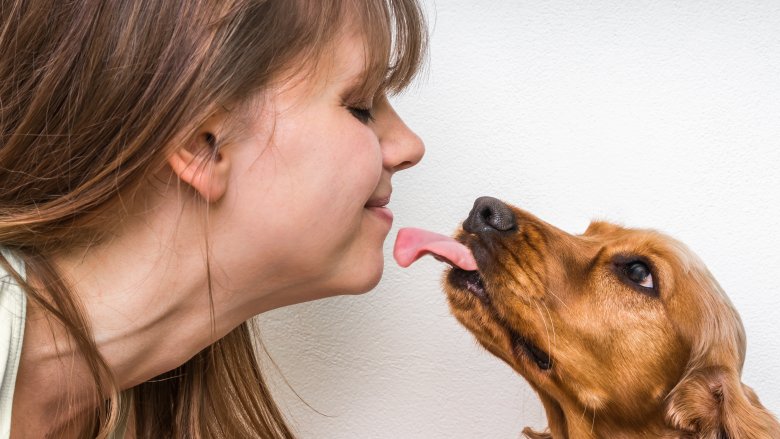Are Dogs' Mouths Really Cleaner Than Humans'?
Friends don't let friends lick them on the face — unless they're being licked by man's best friend. Unlike icky humans who bite their grimy fingernails and eat their boogers when nobody's looking, dogs are commonly believed to have mouths that are almost as pure as their hearts. Of course...these are mouths that lick their puppies' private parts to induce peeing and pooping and which occasionally eat poop out of sheer boredom, malnutrition, or to get attention. But surely, those crotch-licking poop-eaters' mouths are cleaner than a human's, right?
Unfortunately, that's a steaming pile of wrong — dogs' mouths are at the very least as disgusting as our own. Despite all the anti-bacterial turds they're presumably eating, dogs' mouths carry more than 600 kinds of bacteria, according to the American Kennel Club. That's roughly on par (or should we say on paw?) with the 615 types of bacteria discovered in human pie holes. That might be hard to swallow, considering that people have spent forever and several days touting the powers of dog mouths. Even the ancient Greeks and ancient Egyptians placed their faith in dog spit, believing it had special healing properties. To be fair, it sort of does. Canine saliva contains proteins called histatins that combat infection. But so does your saliva, as well as the saliva of other mammals.
Of course, not all bacteria are made equally, and you might wonder if a dog's mouth germs pose a threat to humans. For the most part, the answer is no, but there are some rare yet glaring examples. As explained in a National Geographic article, the mouths of healthy canines (and cats for that matter) harbor Capnocytophaga canimorsus, which can have devastating effects if it infects an open wound.
The article relays the story of a woman named Julie McKenna, who in 2007 lost "her left leg below the knee, part of her right foot, and every one of her fingers and toes" after her puppy licked a mild burn wound Mckenna suffered on her foot. Capnocytophaga canimorsus entered her bloodstream, ultimately resulting in septic shock, organ failure, and her limbs turning black.
Meanwhile, in 2019 Today reported on a similarly terrifying case. A man named Greg Manteufel had to have his nose, hands, and legs amputated after his dog licked him. According to one study, "26 percent of people with confirmed C. canimorsus infections died."
Dogs can also transmit meningitis via the Pasteurella multocida frequently found in their mouths. An estimated 10 to 15 percent of dog bites (and half of cat bites) lead to infection. So maybe a dog's bite is worse than its bark, after all. And in very rare case, its tongue is the worst of all.
